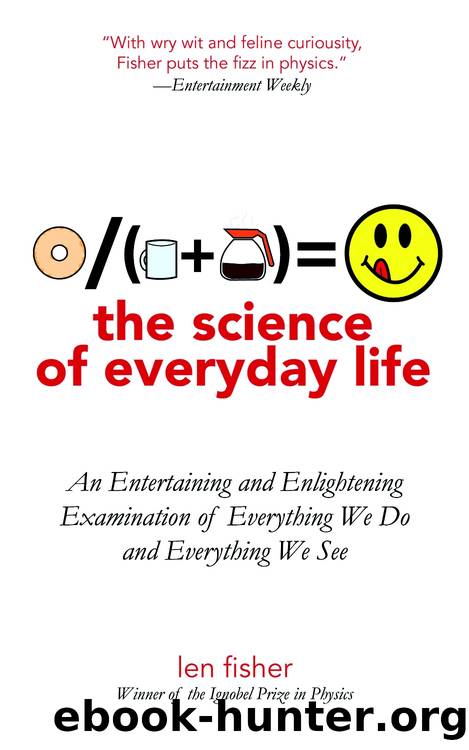The Science of Everyday Life by Len Fisher

Author:Len Fisher
Language: eng
Format: epub
Publisher: Skyhorse Publishing
Published: 2011-05-17T16:00:00+00:00
Figure 7.6: Packing Strategies for Surface-Active Molecules with Different Shapes.
How Do Molecules Shape Up?
The idea that molecules have three-dimensional shapes goes back to Louis Pasteur, whose deduction in 1844 arose from the fact that solutions of two chemical compounds with apparently identical composition could nevertheless twist a beam of light in opposite directions. The difference, he thought, must be because the molecules of the compounds have different three-dimensional shapes.
Pasteur was right, and his observations led to the modern subject of stereochemistry, the science of molecular shapes and how these shapes affect molecular behavior. It was the subject of my very first research project, and nearly my last. The project was to measure the shapes of some small molecules called sulfoxides dissolved in benzene, a highly inflammable solvent. The technique, called the Kerr effect, followed Pasteur in using the twisting of a light beam to provide information about the molecules that could be used to deduce details of their shapes. To make the light rotate sufficiently, though, the molecules had to be aligned in a strong electric field, which means putting ten thousand volts across the solution.
In such a situation, a spark would have caused a catastrophic explosion just a couple of centimeters away from my eye, and the benzene had to be thoroughly dried to prevent this from happening. I did this by the approved technique of adding fresh sodium metal to take up the residual water. Unfortunately, I failed to notice that a speck of sodium was still present when I disposed of some residual benzene down the sink (a procedure that would never be allowed these days). The sodium reacted vigorously with the water in the pipes, producing a jet of flaming hydrogen that in turn set fire to the benzene, sending a scorching flame up the laboratory wall and nearly putting paid to my scientific career before it had fairly started.
Indirect approaches like the Kerr effect have been largely replaced by direct techniques, such as X-ray crystallography, that permit the experimenter to measure the positions in space of all of the individual atoms in a molecule. X-ray crystallography, which works with any material that can be persuaded to form a solid crystal, however tiny, was the technique that permitted the helical structure of DNA to be worked out in the early 1950s. The technique has now progressed so far that scientists can even use it to watch enzymes swallow their molecular prey and regurgitate it in a different form in real time.
Even more exciting than X-ray crystallography is the new technique of scanning probe microscopy, which permits scientists to see individual molecules — or, at least, to feel them. The technique is similar to that used by a blind person who waves a white cane back and forth on the pavement as he or she walks. The cane senses bumps and dips in the path, and could in principle be used to map its contours. Scanning probe microscopy does the same thing at an atomic level, with
Download
This site does not store any files on its server. We only index and link to content provided by other sites. Please contact the content providers to delete copyright contents if any and email us, we'll remove relevant links or contents immediately.
The Complete Stick Figure Physics Tutorials by Allen Sarah(6630)
Secrets of Antigravity Propulsion: Tesla, UFOs, and Classified Aerospace Technology by Ph.D. Paul A. Laviolette(3430)
Thing Explainer by Randall Munroe(3318)
The River of Consciousness by Oliver Sacks(2988)
The Order of Time by Carlo Rovelli(2708)
I Live in the Future & Here's How It Works by Nick Bilton(2520)
A Brief History of Time by Stephen Hawking(2470)
How To by Randall Munroe(2464)
The Great Unknown by Marcus du Sautoy(2178)
What If?: Serious Scientific Answers to Absurd Hypothetical Questions by Randall Munroe(2166)
Blockchain: Ultimate Step By Step Guide To Understanding Blockchain Technology, Bitcoin Creation, and the future of Money (Novice to Expert) by Keizer Söze(2134)
Midnight in Chernobyl by Adam Higginbotham(2075)
Networks: An Introduction by Newman Mark(1994)
The Meaning of it All by Richard Feynman(1905)
Easy Electronics by Charles Platt(1859)
The Tao of Physics by Fritjof Capra(1841)
When by Daniel H Pink(1771)
Midnight in Chernobyl: The Untold Story of the World's Greatest Nuclear Disaster by Adam Higginbotham(1770)
Introducing Relativity by Bruce Bassett(1750)
